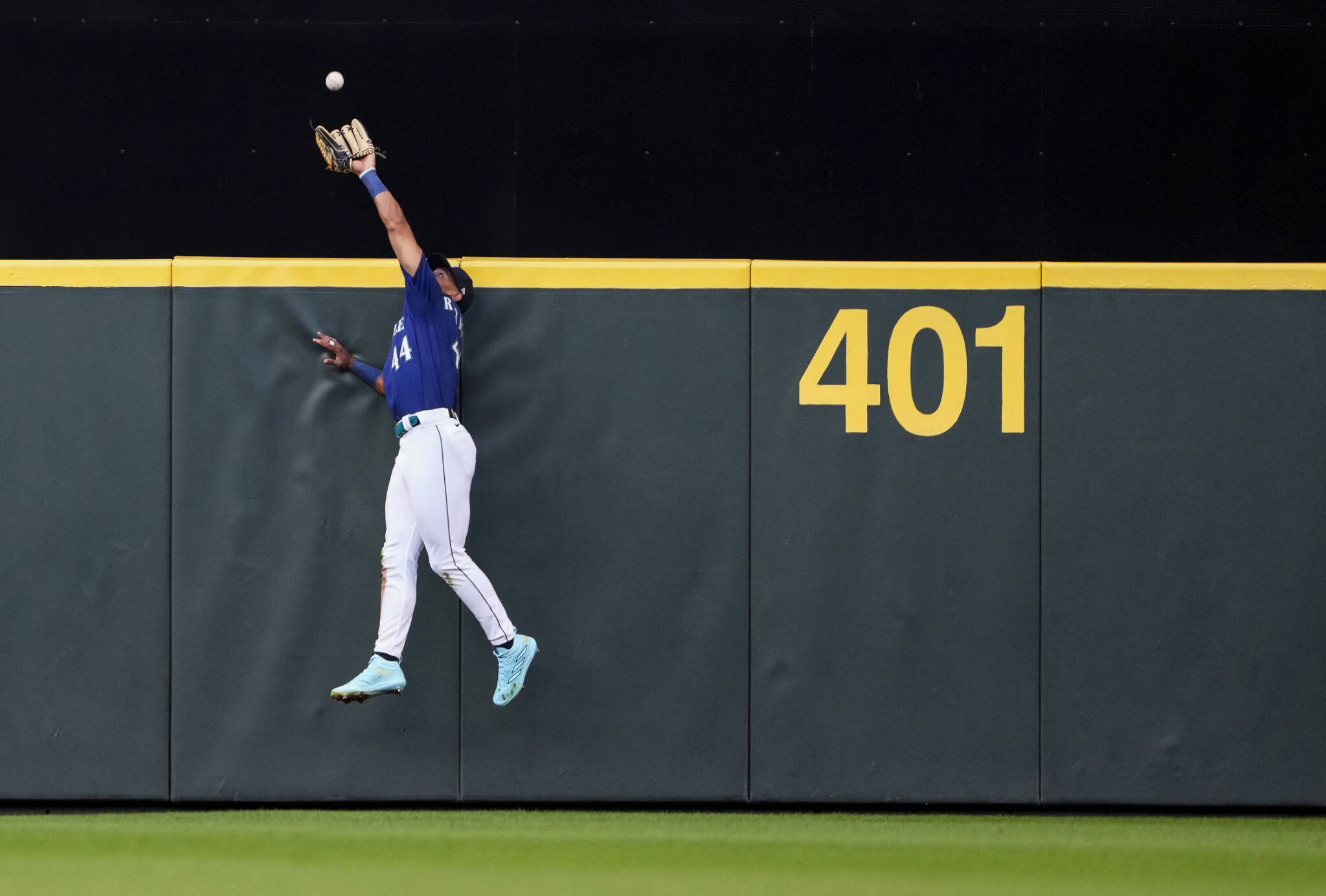By Adam Jude / The Seattle Times
SEATTLE — During his first spring training in the Seattle Mariners’ big-league camp a few years ago, Julio Rodriguez made what, in that moment, sounded like a bold proclamation to Mike Cameron.
“I’m going to be the center fielder for this team,” Rodriguez, then 18, told the retired three-time Gold Glove-winning center fielder.
“I was like, ‘Dude, get out of here, man. Go over and make your money in right field,’” Cameron responded.
Three years later, Rodriguez proved himself right, becoming, at 21, the opening-day center fielder for the Mariners in 2022.
Now, more than a year later, Rodriguez is, according to some metrics, the most valuable defensive center fielder in the majors. His home-run-robbing antics of Fernando Tatis Jr. on Tuesday night put a spotlight on his determination to become just that.
Rodriguez spent time with three of the best outfielders in franchise history — Cameron, Ichiro and Franklin Gutierrez, now special-assignment coaches who, between them, have 14 Gold Gloves.
Could Rodriguez be the Mariners’ next Gold Glove center fielder?
“He’s worked really hard at it,” Cameron said. “I know everyone was (initially) worried about him playing center field, but he’s done a tremendous job. I’ve him seen up close and personal make some plays that I didn’t think he could make.”
Like Cameron, most talent evaluators had projected Rodriguez as a corner outfielder as he was climbing the minor league ranks. Listed now at 6-foot-3 and 228 pounds, he reworked his body in the winter coming into the 2022 season — notably improving his speed and agility — intent to not only make the major league roster, but become a viable center fielder.
The Mariners had promised him that opportunity, to win the center-field job, but no one was quite sure what to expect from him defensively going into that spring training.
Ichiro was confident Rodriguez could handle it.
“During his first spring training, I had the opportunity to run around with him, play catch and do all those things with him,” Ichiro said through interpreter Allen Turner on Wednesday afternoon at T-Mobile Park. “I realized he’s faster than he looks. He’s doesn’t look as fast as he really is. He’s really fast. He’s under control. He’s even-keel. So I knew he could play center. I thought that he was destined to be a center fielder.”
As Rodriguez has gained more experience, Ichiro said he’s noticed a more aggressive, attacking-style approach to fly balls. Which is what allowed Rodriguez to make three spectacular catches Tuesday — the leaping at the wall to rob Tatis; a sliding grab in the third inning coming in on a soft line drive off the bat of Garrett Cooper; and covering 86 feet in 4.6 seconds, according to Statcast, to take extra bases away from Jake Cronenworth in the fifth inning.
“Before, he was maybe a little hesitant while he was still trying to learn his capabilities,” Ichiro said. “That aggressiveness is there (now). You see his confidence.”
Ichiro has worked with Rodriguez each spring, and they’ve spent a lot of time on improving Rodriguez’s arm strength and, more than anything, on the accuracy of this throws.
“He was just as hungry coming into spring training this year, wanting to learn, wanting to get better, wanting to really get after. He’s the type that won’t change (his mentality), which I think is what differentiates him from some other players and why he’s successful and will continue to be.
Rodriguez ranks No. 1 among all MLB outfielders — and No. 3 among all players, regardless of position — in the Outs Above Average measurement. He’s credited with 12 OAA this season.
According to Baseball Savant, OAA is “a range-based metric of fielding skill that accounts for the number of plays made and the difficulty of them,” (Yes, the same metric that ranks Mariners shortstop J.P. Crawford among the very worst defenders in MLB, so make of that what you will.)
Mariners first-base coach Kristopher Negron, who works with outfielders, said one point of emphasis this year with Rodriguez has been his reads off the bat. And that’s been especially important on line drives hit right in front of him, which is typically the most difficult play for most center fielders coming in.
“When he puts his mind to it, he can do anything,” Negron. “He is definitely tracking stuff down, which is really impressive to watch, especially for a guy his size. And I think he’s just going to keep getting better and better.”
Talk to us
> Give us your news tips.
> Send us a letter to the editor.
> More Herald contact information.

























